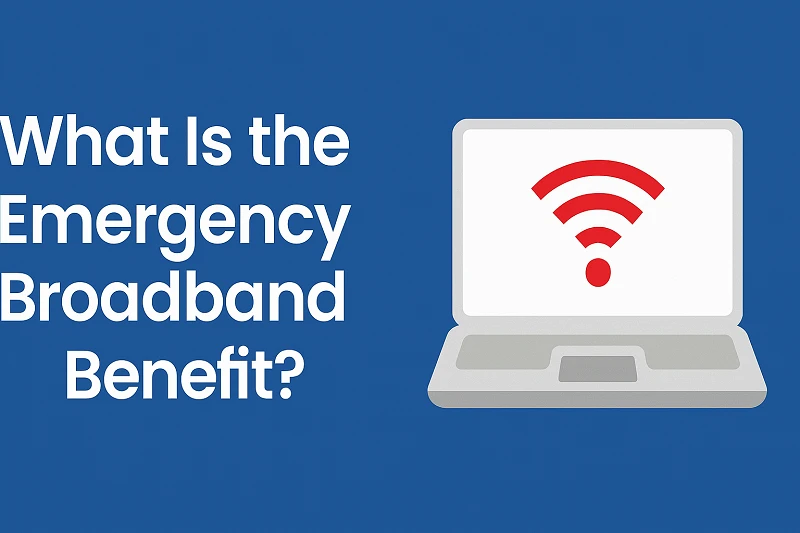
The Emergency Broadband Benefit (EBB) was a temporary federal assistance program in the United States designed to help low-income households afford reliable internet service during the COVID-19 pandemic. Though now replaced by the Affordable Connectivity Program (ACP), understanding the EBB and its legacy remains valuable for Americans seeking affordable internet options or transitioning to new broadband affordability programs.
What Was the Emergency Broadband Benefit Program?
The Federal Communications Commission (FCC) launched the Emergency Broadband Benefit in early 2021 as part of the U.S. government’s pandemic relief efforts. The initiative aimed to keep families connected during a time when remote work, online education, and telehealth became essential for everyday life.
Eligible households could receive substantial financial relief on their monthly internet bills:
-
Up to $50 per month off broadband service
-
Up to $75 per month for households on qualifying Tribal lands
-
A one-time device discount of up to $100 for a laptop, desktop computer, or tablet (with a co-payment of more than $10 and less than $50).
Each household could receive only one service and one device discount under the program.
Who Was Eligible for the EBB?
The program targeted individuals and families who struggled to afford internet access. Eligibility criteria included :
-
Households with income at or below 135% of the Federal Poverty Guidelines
-
Participants in government programs such as SNAP, Medicaid, or Lifeline
-
Families with children receiving free or reduced-price school meals
-
Recipients of a Federal Pell Grant during the current academic year
-
Those who experienced significant income loss due to job loss or furlough during the pandemic
This inclusive approach ensured that millions of Americans—especially students, remote workers, veterans, and seniors—could stay online during critical times.
How the Program Worked ?
Applicants could apply through several convenient methods:
-
Online: By visiting GetEmergencyBroadband.org and submitting an application
-
Through a Provider: Many internet service providers (ISPs) such as Spectrum, AT&T, and Xfinity participated directly in the program
-
By Mail: Applicants could send proof of eligibility to the Emergency Broadband Support Center.
Once approved, participants selected a qualified broadband plan from an approved provider. The monthly federal contribution reduced their out-of-pocket costs, making home internet more affordable and accessible.
Transition to the Affordable Connectivity Program (ACP)
Although the EBB was a lifeline during the pandemic, it was temporary. It concluded on December 31, 2021, and transitioned into the Affordable Connectivity Program (ACP). The ACP continued offering similar discounts but at a standardized rate:
-
$30 per month for eligible households
-
$75 per month for households on Tribal lands
-
A one-time device discount of up to $100 for qualifying devices.
The ACP ran successfully until June 2024, when federal funding expired, leaving millions of U.S. households without continued benefits. According to a 2025 report, its end forced nearly 5 million Americans to downgrade or cancel their internet service entirely.
Why Programs Like EBB and ACP Matter?
Access to affordable broadband isn’t a luxury—it’s a modern necessity. From applying for jobs and attending virtual classes to booking medical appointments, nearly every aspect of life in the U.S. depends on internet connectivity. The EBB showed how powerful federal initiatives can be in closing the digital divide and empowering underserved communities.
Reliable, high-speed internet allows students to thrive in online learning, employees to work remotely, and families to access telehealth and government support efficiently. Without affordable options, millions risk being left behind in an increasingly digital society.
How to Find Affordable Internet Now?
Even though the EBB and ACP have ended, many internet service providers across the United States continue to offer low-cost plans inspired by these programs. Providers like Spectrum, Xfinity, and AT&T have introduced their own affordable packages for qualifying customers, often matching or closely resembling previous federal subsidies.
If you’re seeking low-cost internet options:
Check for Local ISP Programs: Major ISPs have ongoing initiatives for low-income families.
Use Nonprofit Resources: Organizations such as PCs for People and EveryoneOn help connect families with affordable broadband and device programs.
Compare and Apply Online: Websites like HighSpeedInternet.com and BroadbandNow.com allow users to compare internet speeds and pricing in their ZIP codes.
Promoting Digital Inclusion
Whether through federal programs or private ISP offers, the ultimate goal remains the same: to ensure every American household has reliable, affordable access to the internet. The Emergency Broadband Benefit set a strong foundation for future digital inclusion efforts, teaching the importance of connectivity as a public necessity rather than a privilege.
If you or someone you know struggles to afford internet service, don’t wait. Explore your local affordable broadband options today. Many leading internet providers continue to support low-cost programs for eligible U.S. residents.
Staying connected means staying informed, employed, and empowered. Affordable internet is not just about convenience—it’s about opportunity. Find the right internet plan for your home today and take the first step toward a better-connected tomorrow.